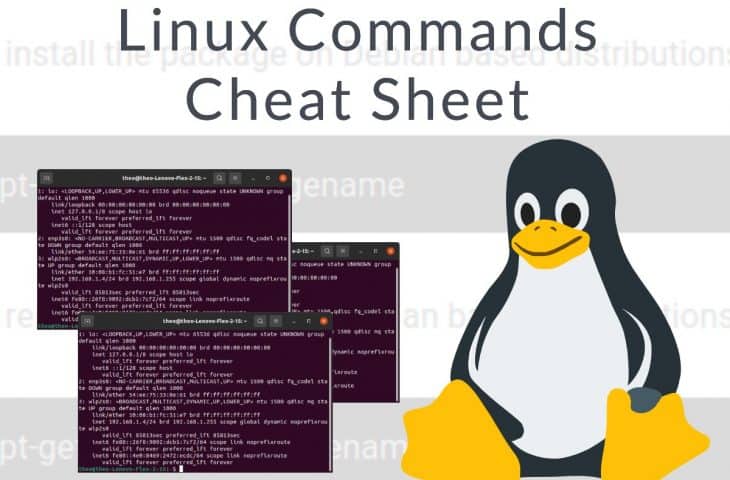Time series decomposition works by splitting a time series into three components: seasonality, trends and random fluctiation. To show how this works, we will study the decompose( ) and STL( ) functions in the R language.
Linux Commands Cheat Sheet
Posted by Armando Brito Mendes | Filed under lições, linguagens de programação, materiais ensino, materiais para profissionais
Uma boa cábula dos comandos Linux principais.
Hitesh J Last Updated : 12/13/2021
There are hundreds – possibly thousands – commands available in Linux. Remembering every command is not possible and it can be quite daunting for a novice user. The good news is that you don’t need to remember each command. Only a very small subset of those commands are used on a day-to-day basis.
This cheat sheet offers a set of commands that you can use for quick reference. I have prepared this Linux Commands Cheat Sheet as quick reference for both experienced and basic users.
Tags: informática, Linux
A Better Way for Data Preprocessing: Pandas Pipe
Posted by Armando Brito Mendes | Filed under Data Science, lições, linguagens de programação, materiais ensino, materiais para profissionais
Um pequeno tutorial sobre como começar a usar o pipe
Efficient, organized, and elegant.
Soner YıldırımJul 31·4 min read
Real-life data is usually messy. It requires a lot of preprocessing to be ready for use. Pandas being one of the most-widely used data analysis and manipulation libraries offers several functions to preprocess the raw data.
In this article, we will focus on one particular function that organizes multiple preprocessing operations into a single one: the pipe function.
When it comes to software tools and packages, I learn best by working through examples. I keep this in mind when creating content. I will do the same in this article.
Tags: pipe, préprocessamento, Python
aRtsy: Generative Art with R and ggplot2
Posted by Armando Brito Mendes | Filed under linguagens de programação, materiais ensino, materiais para profissionais, software, visualização
Um pacote para o R para criar arte generativa
“If you laugh at a joke, what difference does it make if subsequently you are told that the joke was created by an algorithm?” – Marcus du Sautoy, The Creative Code
aRtsy is an attempt at making generative art available for the masses in a simple and standardized format. The package provides various algorithms for creating artworks in ggplot2 that incorporate some form of randomness (depending on the set seed). Each type of artwork is implemented in a separate function.
Good luck hunting for some good seed’s! Feel free to post a comment with your best artworks and the corresponding seed in the GitHub discussions.
Contributions to aRtsy are very much appreciated! If you want to add your own type of artwork to the package so that others can also create them, feel free to make a pull request to the GitHub repository. Don’t forget to adjust generate-artwork.R if you also want the artwork to show up in the ‘Artwork of the day’ category and the twitter feed.
API Integration in Python
Posted by Armando Brito Mendes | Filed under linguagens de programação, materiais para profissionais, software
able of Contents
- How to Make Friends and Influence APIs
- Talking REST
- Constructing an API Library
- Coming in Part 2
- Appendix: REST in a nutshell
Build Pipelines with Pandas Using pdpipe
Posted by Armando Brito Mendes | Filed under linguagens de programação, software
Boa descrição de pipelines com os data.frame do Pandas.
Pandas is an amazing library in the Python ecosystem for data analytics and machine learning. They form the perfect bridge between the data world, where Excel/CSV files and SQL tables live, and the modeling world where Scikit-learn or TensorFlow perform their magic.
A data science flow is most often a sequence of steps — datasets must be cleaned, scaled, and validated before they can be ready to be used by that powerful machine learning algorithm.
These tasks can, of course, be done with many single-step functions/methods that are offered by packages like Pandas but a more elegant way is to use a pipeline. In almost all cases, a pipeline reduces the chance of error and saves time by automating repetitive tasks.
In the data science world, great examples of packages with pipeline features are — dplyr in R language, and Scikit-learn in the Python ecosystem.
A data science flow is most often a sequence of steps — datasets must be cleaned, scaled, and validated before they can be ready to be used
Following is a great article about their use in a machine-learning workflow.
Managing Machine Learning Workflows with Scikit-learn Pipelines Part 1: A Gentle Introduction
Are you familiar with Scikit-learn Pipelines? They are an extremely simple yet very useful tool for managing machine…
Pandas also offer a .pipe method which can be used for similar purposes with user-defined functions. However, in this article, we are going to discuss a wonderful little library called pdpipe, which specifically addresses this pipelining issue with Pandas DataFrame.
In almost all cases, a pipeline reduces the chance of error and saves time by automating repetitive tasks
Tags: data mining, pandas, pipelines, Python
Usage of Asterisks in Python
Posted by Armando Brito Mendes | Filed under linguagens de programação
Um tutorial sobre os vários usos do * no Python
Most of us use asterisks as multiplication and power operators, but they also have a wide range of operations being used as a prefix operator in Python. After reading this article, you will get to know the full usage of asterisks.
Asterisks have many particular use cases in Python. In general, we are familiar with the multiplication and power operators. It can perform some other operations like unpacking, arguments passing, etc.., in different situations. First, let’s see the general usage of asterisks.
Tags: Python
Extracting Seasonality and Trend from Data: Decomposition Using R
Posted by Armando Brito Mendes | Filed under estatística, Investigação Operacional, lições, linguagens de programação, materiais ensino, materiais para profissionais
Uma excelente descrição da decomposição clássica com Python e R.
Understanding Decomposition
Decompose One Time Series into Multiple Series
Time series decomposition is a mathematical procedure which transforms a time series into multiple different time series. The original time series is often split into 3 component series:
- Seasonal: Patterns that repeat with a fixed period of time. For example, a website might receive more visits during weekends; this would produce data with a seasonality of 7 days.
- Trend: The underlying trend of the metrics. A website increasing in popularity should show a general trend that goes up.
- Random: Also call “noise”, “irregular” or “remainder,” this is the residuals of the original time series after the seasonal and trend series are removed.
Tags: engenharia, inferência, otimização, previsão
MySQL Documentation
Posted by Armando Brito Mendes | Filed under linguagens de programação, materiais para profissionais, software
Montes de documentação sobre todos os produtos MySQL
Guardar
Tags: SQL
C Tutorial
Posted by Armando Brito Mendes | Filed under linguagens de programação
Bom tutorial de C on-line.
Learn C with our popular C tutorial, which will take you from the very basics of C all the way through sophisticated topics like binary trees and data structures. By the way, if you’re on the fence about learning C or C++, I recommend going through the C++ tutorial instead as it is a more modern language.
Introduction and Basic C Features
Pointers, Arrays and Strings
File IO and command line arguments
Linked lists, binary trees, recursion
Finished with all these tutorials? Do some practice problems or view more tutorials.
A Growth Hacker’s Journey
Posted by Armando Brito Mendes | Filed under linguagens de programação, software
Dr. Kirk Borne is a Principal Data Scientist at Booz Allen Hamilton. Previously he was a Professor of Astrophysics and Computational Science in the George Mason University School of Physics, Astronomy, and Computational Sciences. He was at Mason from 2003 to 2015, where he taught and advised students in the graduate and undergraduate Computational Science, Informatics, and Data Science programs. Before Mason, he spent nearly 20 years in positions supporting NASA projects, including an assignment as NASA’s Data Archive Project Scientist for the Hubble Space Telescope, and as Project Manager in NASA’s Space Science Data Operations Office. He has extensive experience in big data and data science, including expertise in scientific data mining and data systems. He has published over 200 articles (research papers, conference papers, and book chapters), and given over 200 invited talks at conferences and universities worldwide. In these roles, he focuses on achieving big discoveries from big data through data science, and he promotes the use of information and data-centric experiences with big data in the STEM education pipeline at all levels. He believes in data literacy for all! Learn more about him at http://kirkborne.net/. You can follow him on Google+ here and on Twitter at @KirkDBorne, where he has been identified as one of the social network’s top big data influencers.
Tags: C \ fortran, SQL







